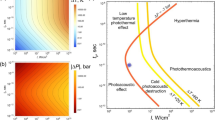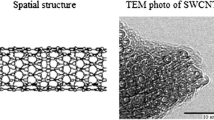Abstract
We report the first application of single-wall carbon nanotubes (SWCNT) as potent therapeutic nanobomb agents for killing breast cancer cells. We show here that by adsorbing water molecules in SWCNT sheets or loosely adsorbed on top of cells, potent nanobombs were created that heated the water molecules inside them to more than 100°C upon exposure to laser light of 800 nm at light intensities of approx 50–200 mW/cm2. Conversion of optical energy into thermal energy, and the subsequent confinement of thermal energy in SWCNT, caused the water molecules to evaporate and develop extreme pressures in SWCNT causing them to explode in solutions. Co-localized nanobombs killed human BT474 breast cancer cells in physiological phosphate-buffered saline (PBS) solution. Cells that were treated with nanobombs exploded into fragments, while the surrounding cells not treated with nanobombs were viable. SWCNT-based nanobomb agents can potentially outperform most nanotechnological approaches in killing cancer cells without toxicity.
Similar content being viewed by others
References
Ferrari, M. (2005), Nat. Rev. Cancer 5, 161–171.
Schmittel, M., Kalsani, V., Fenske, D., and Wiegrefe, A. (2004), Chem. Communi. 5, 490–491.
Yan, H., Finkelstein, G., Reif, J. H., and LaBean, T. H. (2003), Science 301, 1882–1884.
Spillmen, H., Dmitriev, A., Lin, N., Messina, P., Barth, J. V., and Kern, K. (2003), J. Amer. Chem. Soci. 125, 10,725–10,728.
Allain, L. R. and Dinh, T. V. (2002), Anal. Chim. Acta 469, 149–154.
Lizard, G., Duvillard, L., Wedemeyer, N., et al. (2003), Pathol. Biol. 51, 418–427.
Dubertret, S. B., Norris, D. J., Noireaux, V., Brivanlou, A. H., and Libchaber, A. (2002), Science 298, 1759–1762.
Mansson, S. A., Balaz, M., Bunk, R., et al. (2004), Biochem. Biophys. Res. Communi. 314, 529–534.
Wu, X., Liu, J., Haley, K. N., et al. (2003), Nat. Biotechnol. 21, 41–46.
Heverhagen, J. T., Fahr, A., Muller, R., and Alfke, H. (2004), Magne. Reson. Imaging 22, 483–487.
Toyoda, K., Tooyema, I., Kato, M., et al. (2004), Neuroreport 15, 589–593.
Roy, I., Pudavar, H. E., Bergey, E. J., et al. (2003), J. Ameri. Chem. Soci. 125, 7860–7865.
Hirsch, L., Stafford, R. J., Bankson, J. A., et al. (2003), Proc. Natl. Acad. Sci. USA 100, 12,549–12,554.
Loo, C., Lin, A., Hirsch, L., et al. (2004), Technolo. Cancer Res. Treat. 3, 33–40.
Kam, N. W. S., O’Connell, M., Wisdom, J. A., and Dai, H. (2005), Proc. Natl. Acad. Sci. USA 102, 11,600–11,605.
Lam, C. W., James, J. T., McCluskey, R., and Hunter, R. L. (2004), Toxicol. Sci. 77, 126–134.
Ajayan, P., Terrones, M., de la Gaurdia, A., et al. (2002). Science 296, 705.
O’Connell, M. J., Bachilo, S. M., Huffman, C. B. (2002), Science 297, 593–596.
Bachilo, S. M., Strano, M. S., Kittrell, C., Hauge, R. H., Smalley, R. E., and Weisr, R. B. (2002), Science 298, 2361–2366.
Rao, A. M., Eklund, P. C., Bandow, S., Thess, A., and Smalley, R. E. (1997), Nature 388, 257–259.
Berber, S., Kwon, Y. K., and Tomanek, D. (2000), Phys. Rev. Lett. 84, 4613.
Kim, P., Shi, L., Majumdar, A., and McEuen, P. L. Phys. Rev. Lett. 87, 215502.
Osman M. A. and Srivatsava, D. (2001), Nanotechnology, 12, 21.
Hone, J., Whitney, M., Piskoti, C., and Zettl, A. (1999), Phys. Rev. B, 59, R2514.
Author information
Authors and Affiliations
Corresponding author
Rights and permissions
About this article
Cite this article
Panchapakesan, B., Lu, S., Sivakumar, K. et al. Single-wall carbon nanotube nanobomb agents for killing breast cancer cells. Nanobiotechnol 1, 133–139 (2005). https://doi.org/10.1385/NBT:1:2:133
Issue Date:
DOI: https://doi.org/10.1385/NBT:1:2:133




